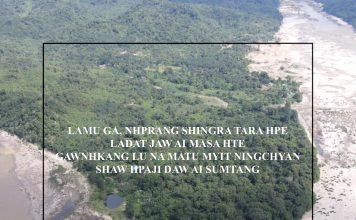
In 2018, Burmese government troops stepped up their war in Kachin State, further driving out indigenous populations and ex-panding control over the area’s rich natural resources and strategic tradingroutes.Thefiercestoffensivewas fought in northwest Kachin State’s Hugawng Valley, to secure the historic Ledo Road linking India and China, which is part of China’s Belt and Road Initiative, and to seize hugely lucrative amber mines.
Kachin State amber is a global treasure: it is the only type in the world formed during the age of the dinosaurs. “Blood amber” is the Chinese name of the extremely rare, deep red variety of the gem found only in the Hugawng Valley – a name which resonates grimly with local residents who have been driven outbytherecentoffensive.
The amber mining boom began in 2010, due to demand from the Chinese market, causing tens of thousands of migrant miners from acrossBurmatoflocktotheregion.In 2015, discovery of a 99-million-year-old feathered dinosaur tail in Hugawng Valley amber further fuelled the trade.
The Kachin Independence Army (KIA) controlled the remote amber mining area, but the Burma Army collected taxes on all amber trans-port routes as the precious resource was exported across Kachin State into China, where the annual value of the trade is estimated at 1 billion USD a year.
In June 2017, the Burma Army moved to take over the amber trade at the source. They used aircraft to drop thousands of leaflets over the mining area, ordering all local residents to evacuate within ten days – or be branded as KIA insurgents.This included not only the mineworkers but also nearly 5,000 indig-enous villagers who had lived andfarmed there for generations.
The offensiv elasted nearly one year, during which civilians suffered not only the seizure of their lands and property, but also military harass-ment and violence. On January 26, 2018, three civilians were killed by an aerial attack, including the young mother of a 3 year-old child. In January 2018, nearly 3,000 civilians were trapped in the con-flictareabytheBurmaArmy,whorefused to allow them to pass to safety, holding them for eleven days without proper food or healthcare and blocking delivery of humanitar-ian aid. To this day, the thousands of indigenous inhabitants of the amber mining area are living in makeshift shelters in urban church compounds, unrecognized as IDPs and unable to return home.
In January 2018, nearly 3,000 civilians were trapped in the con-flictareabytheBurmaArmy,whorefused to allow them to pass to safety, holding them for eleven days without proper food or healthcare and blocking delivery of humanitar-ian aid. To this day, the thousands of indigenous inhabitants of the amber mining area are living in makeshift shelters in urban church compounds, unrecognized as IDPs and unable to return home.

Despite using the premise of “pro-tecting the environment” to justify theoffensive,unregulatedambermining resumed in the region just oneyearaftertheoffensivebegan,exposing the Burma military’s real motives in seizing the mines.
The offensive follow sarepeated pattern of military expansion and violence against ethnic peoples in Kachin State in order to consolidate extractive businesses to profit the military and central government at the expense of local indigenous populations.
Past documentation by KDNG has already shown that, far from protecting the environment, the government and military has been responsible for large-scale environ-mental destruction in the Hugawng Valley over the last 20 years. It has authorized destructive gold mining throughout the valley, and given per-mission for Yuzana Company to de-stroy hundreds of acres of forest and farmlands to carry out monocrop agriculture for the Chinese market. Similarly in nearby Hpakant, jade mining has expanded exponentially since government security forces seized control of the mines, generat-inghugeprofitsforgovernmentandmilitary elites, while driving local peopleofftheirlandsanddestroyingtheir livelihoods.
The central government must recog-nize the rights of indigenous peoples to live on their land and manage their own resources, and must im-mediately take steps to allow people displaced from the amber region to return home.
Constitutional change is critical to resolve conflict in Burma.Localpeople in Kachin State must own, manage, and receive revenues from the natural resources of the land where they live and work.
International pressure is urgently needed to help protect civilians in conflict zones in Kachin State and elsewhere in Burma. Foreign eco-nomic investment and peace process funding should be frozen until the Burma military stop sits offensives against Kachin and other ethnic peoples. In the meantime, interna-tional humanitarian aid should be sent to help communities displaced from their homes and livelihoods by central government aggression. Read more …







